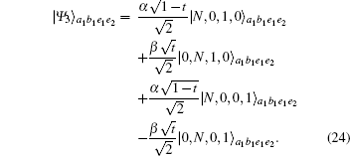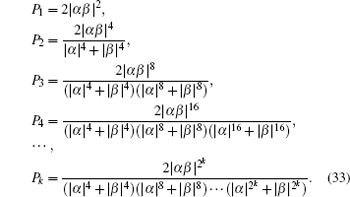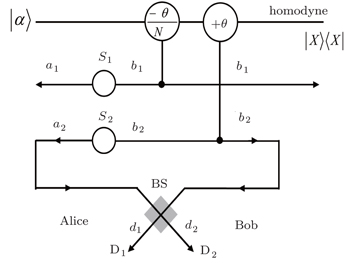† Corresponding author. E-mail:
Project supported by the National Natural Science Foundation of China (Grant Nos. 11474168 and 61401222), the Qing Lan Project of Jiangsu Province of China, the Natural Science Foundation of Jiangsu Province of China (Grant No. BK20151502), and the Project Funded by the Priority Academic Program Development of Jiangsu Higher Education Institutions.
We put forward two efficient entanglement concentration protocols (ECPs) for arbitrary less-entangled NOON state. Both ECPs only require one pair of less-entangled NOON state and an auxiliary photon. In the first ECP, the auxiliary photon is shared by two parties, while in the second ECP, the auxiliary photon is only possessed by one party, which can increase the practical success probability by avoiding the transmission loss and simplify the operations. Moreover, both ECPs can be used repeatedly to get a high success probability. Based on the above features, our two ECPs, especially the second one, may be useful in the quantum information processing.
Entanglement plays a significant role in the quantum information field. For example, quantum teleportation,[1,2] quantum densecoding,[3] quantum secret sharing,[4] quantum computation,[5–7] communication,[8–10] protocols[11–22] all require entanglement to set up the quantum entanglement channels. Recently, a special quantum state, which is the so-called NOON state, has attracted much attention.[23–29] The NOON state can be written with the form of

The method for recovering the pure less-entangled state into the maximally entangled state is called the entanglement concentration. In 1996, Bennett et al. proposed the first entanglement concentration protocol (ECP), which is known as the Schmidt projection method.[36] Since then, various interesting ECPs have been put forward, successively.[37–78] For example, in 1999, Bose et al. proposed an ECP based on entanglement swapping,[37] which was later improved by Shi et al.[38] In 2001, Zhao et al. and Yamamoto et al. proposed two similar concentration protocols based on polarizing beam splitters (PBSs) independently.[39,40] In 2008, Sheng et al. developed their protocols with the help of the cross-Kerr nonlinearity.[41] So far, most of the ECPs are focused on the two-particle entanglement, especially the encoding system in the polarization degree of freedom of the optical system. They cannot deal with the less-entangled NOON state. Recently, we have proposed an ECP for the less-entangled NOON state.[44] In the protocol, two pairs of less-entangled NOON states are required. After performing this ECP, one pair of maximally entangled NOON state can be obtained. As the NOON state is precious, this protocol is not optimal.
In the present paper, we put forward two efficient ECPs for arbitrary less-entangled NOON state. Different from the previous ECP,[44] both of our ECPs only require one pair of less-entangled NOON state and a single auxiliary photon to complete the concentration task and can reach the same success probability as Ref. [44]. In the two ECPs, we adopt the cross-Kerr nonlinearity to construct the quantum nondemolition detection (QND) gate, which means the obtained maximally entangled NOON state can be kept for other applications. Moreover, both the ECPs can be used repeatedly to get a high success probability. The second ECP is more optimal than the first one, for it only requires the local single auxiliary photon, which can effectively avoid the photon loss during the transmission process. Moreover, one party can perform the whole task which can simplify the practical experiment largely.
This paper is organized as follows: In Sections 2 and 3, we explain the basic principles of the first and the second ECPs, respectively. Some discussions are made in Section 4, and a summary is given in the last section.
The cross-Kerr nonlinearity is the key element of both ECPs. Therefore, we would like to make a brief introduction about it first. The cross-Kerr nonlinearity has been widely used in the quantum information field. It has played an important role in the construction of CNOT gate,[79,80] Bell-state analysis,[81,82] and so on.[83–92] In particular, the cross-Kerr nonlinearity is a powerful tool in the construction of the QND gate, which is widely used in the quantum entanglement concentration.[41–43,55,57] The cross-Kerr nonlinearity can be described by its Hamiltonian as


Now, we start to explain the first ECP for arbitrary less-entangled NOON state. The principle of the ECP is shown in Fig.

A single-photon entanglement source S2 emits an auxiliary photon and sends it to Alice and Bob in the spatial modes a2 and b2, which creates a single-photon entangled state of the form

In this way, the whole (N + 1)-photon system can be described as

According to Fig.


Then, Alice and Bob make the photons in the modes a2 and b2 pass through the 50:50 BS, which makes




Finally, the output photons in the spatial modes d1 and d2 are detected by the single-photon detectors D1 and D2, respectively. If the detector D1 fires, the state in Eq. (


Both |ϕ1〉a1b1 and 

Moreover, we will prove that the ECP can be reused to further concentrate the discarded items. In the first ECP, the discarded items which make the coherent state pick up no phase shift can be written as


It can be found that |ϕ2〉a1b1 has a similar form to the initial NOON state in Eq. (



Similarly, by making the discarded items in the second concentration round pass through the BS and detect the output photons, the parties can ultimately obtain a new less-entangled NOON state as


The schematic diagram of our second ECP is shown in Fig.


Bob makes the photons in the spatial mode b1 and c1 pass through the QND gate, and the whole (N + 1)-photon system combined with the coherent state can evolve to

It can be seen that the items 




Then, Bob makes the photons in the spatial modes c1 and c2 pass through the 50:50 BS, which makes





Moreover, we can also prove that the second ECP can be used repeatedly. When t = α2, the discarded items in the first concentration round can be written as

In the second concentration round, the single photon source S2 provides a new auxiliary single photon to Bob. Bob makes it pass through another VBS with the transmittance of t2, where the subscript “2” means in the second concentration round. A new single-photon entangled state with the similar form of Eq. (


Next, Bob makes the photons in the spatial modes c1 and c2 pass through the BS, and detects the output photons. In this way, 

If we can find a suitable VBS with the form



Similarly, by making the discarded items in the second concentration round pass through the BS, the discarded items can also evolve to a new less-entangled NOON state, which can be reconcentrated in the next round. Therefore, by choosing the suitable VBSs with the transmittance

Finally, we would like to calculate the total success probability of these two ECPs. According to the description mentioned above, both ECPs have the same success probability. In each concentration round, the success probability can be written as

In theory, the ECPs can be reused indefinitely, and the total success probability equals the sum of the probability in each concentration round, which can be described as

It can be found that if the initial entangled state is the maximally entangled NOON state, where 

In the paper, we presented two efficient ECPs for distilling the maximally entangled N-photon NOON state from an arbitrary less-entangled NOON state. It is interesting to compare these two ECPs with our previous ECP for the N-photon NOON state.[44] In the ECP of Ref. [44], the parties need to consume two pairs of less-entangled NOON states to distill one pair of maximally entangled NOON state, while the current two ECPs only require one pair of less-entangled NOON state and an auxiliary single photon, which can reach the same high success probability as that in Ref. [44]. zhouqip1. As the NOON state is quite precious, the current two ECPs are more economical. On the other hand, the previous ECP in Ref. [44] zhouqip1 require the two parties to take the coincidence measurement for a pair of NOON state, which will increase the operation difficulty, especially when the photon number N is large. In the current two ECPs, we only need to measure the auxiliary single photon, which can simplify the operation largely. Therefore, the two current ECPs are more advantageous than the previous one.
Comparing the two current ECPs, it looks that if we change the spatial modes c1 and c2 to b1 and b2, and make the transmittance of the VBS meet t = 0.5, the second ECP can be transformed to the first ECP. However, it is noteworthy that the second ECP is more optimal than the first one. In the first ECP, the auxiliary photon should be shared by Alice and Bob in two distant locations. It requires the entangled photon source, which is precious under current experimental condition. Moreover, after passing through the QND gate, the two parties need to make the coincidence measurement of the auxiliary single-photon entangled state, which is difficult in practical experiment. Moreover, in the first ECP, the auxiliary photon in Alice’s hand should be sent back and will be transmitted for a second time. As pointed out by Ref. [94], the decoherence and photon loss are unavoidable during the transmission process due to the environmental noise. It will limit the application of the first ECP in the practical applications. Fortunately, in the second ECP, the auxiliary photon entanglement can be created locally with the help of the VBS and only possessed by Bob. Only Bob needs to operate this concentration process, which makes this ECP more advantageous in practical applications.
In the second ECP, the VBS is the key element for creating the local single-photon entanglement. According to the initial coefficients of the less-entangled NOON state, the parties should provide the VBSs with the transmittance of

Finally, we will discuss another key element of both ECPs, that is, the cross-Kerr nonlinearity. Although the cross-Kerr nonlinearity has been widely discussed in quantum information processing,[80,81,83–85,96] it has been regarded as a controversial topic in practical experiment for a long time.[97–99] First, the qubit states may degrade to the mixed states in the homodyne detection process.[100,101] Second, the natural cross-Kerr nonlinearity is extremely weak, so that it is difficult to discriminate two overlapping coherent states in homodyne detection. Fortunately, the decoherence can be extremely weak simply by an arbitrary strong coherent state associated with a displacement D (−α) performed on the coherent state.[100] On the other hand, it is possible to obtain an observable cross-Kerr phase shift with the help of the weak measurement.[102] As early as 2003, Hofmann showed that with the help of a single two-level atom trapped in a one-sided cavity, we can obtain a phase shift as large as π.[103] Meanwhile, as shown in Ref. [104], large cross-Kerr nonlinearities were also obtained in a double-quantum-well structure with a four-level, double-type configuration. The “giant” cross-Kerr effect with phase shift of 20° per photon has been observed in the current experiment.[105] Recent work of the Xiao group also showed that the Rydberg atom system can generate large cross phase between photons.[106] According to the recent theoretical and experimental works based on cross-Kerr nonlinearity, the cross-Kerr nonlinearity may provide its practical application in the future quantum information processing.
In summary, we put forward two efficient ECPs for distilling the maximally entangled N-photon NOON state from arbitrary less-entangled NOON state. In both ECPs, we only require one pair of less-entangled NOON state and an auxiliary single photon to complete the task. Moreover, with the help of the cross-Kerr nonlinearity, both ECPs can be used repeatedly. In this way, they can both obtain high success probability. Comparing with our previous ECP of the NOON state, the two current ECPs are more economical and easy to operate. In the first ECP, the auxiliary single photon should be shared by the two parties, and the two parties need to take the coincidence measurement for the auxiliary photon. The second ECP is more optimal than the first one. In the second ECP, the auxiliary single photon is only possessed by Bob benefitting from the VBS, which can reduce the requirement for the single-photon source. Meanwhile, as all the operations are local, the second ECP is easier to operate than the first one. In particular, in the second ECP, as the auxiliary single photon does not need to transmit in a long-distance channel, the second ECP can effectively reduce the docoherence and photon loss in the transmission process. In this way, the second ECP is more advantageous in practical applications. Based on the features described above, our two ECPs, especially the second ECP may be useful and convenient in quantum information processing.
| 1 | |
| 2 | |
| 3 | |
| 4 | |
| 5 | |
| 6 | |
| 7 | |
| 8 | |
| 9 | |
| 10 | |
| 11 | |
| 12 | |
| 13 | |
| 14 | |
| 15 | |
| 16 | |
| 17 | |
| 18 | |
| 19 | |
| 20 | |
| 21 | |
| 22 | |
| 23 | |
| 24 | |
| 25 | |
| 26 | |
| 27 | |
| 28 | |
| 29 | |
| 30 | |
| 31 | |
| 32 | |
| 33 | |
| 34 | |
| 35 | |
| 36 | |
| 37 | |
| 38 | |
| 39 | |
| 40 | |
| 41 | |
| 42 | |
| 43 | |
| 44 | |
| 45 | |
| 46 | |
| 47 | |
| 48 | |
| 49 | |
| 50 | |
| 51 | |
| 52 | |
| 53 | |
| 54 | |
| 55 | |
| 56 | |
| 57 | |
| 58 | |
| 59 | |
| 60 | |
| 61 | |
| 62 | |
| 63 | |
| 64 | |
| 65 | |
| 66 | |
| 67 | |
| 68 | |
| 69 | |
| 70 | |
| 71 | |
| 72 | |
| 73 | |
| 74 | |
| 75 | |
| 76 | |
| 77 | |
| 78 | |
| 79 | |
| 80 | |
| 81 | |
| 82 | |
| 83 | |
| 84 | |
| 85 | |
| 86 | |
| 87 | |
| 88 | |
| 89 | |
| 90 | |
| 91 | |
| 92 | |
| 93 | |
| 94 | |
| 95 | |
| 96 | |
| 97 | |
| 98 | |
| 99 | |
| 100 | |
| 101 | |
| 102 | |
| 103 | |
| 104 | |
| 105 | |
| 106 |





